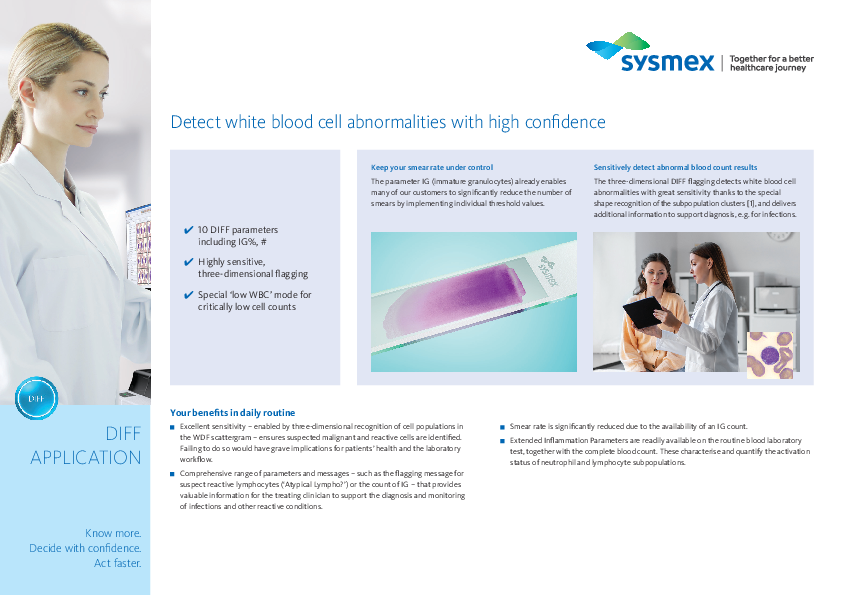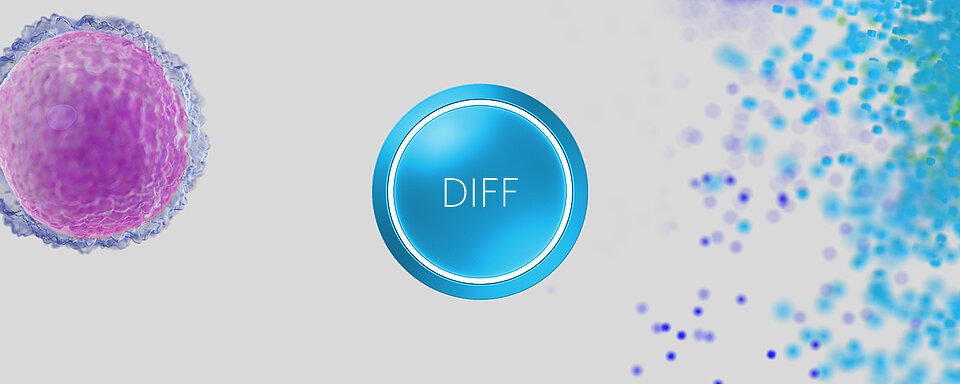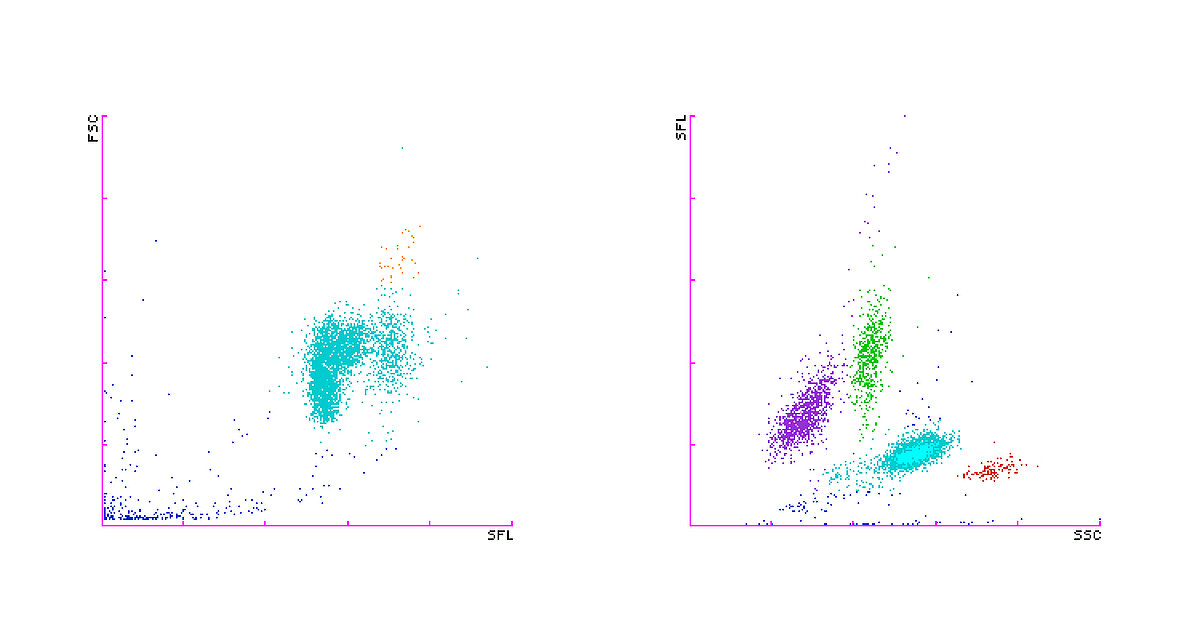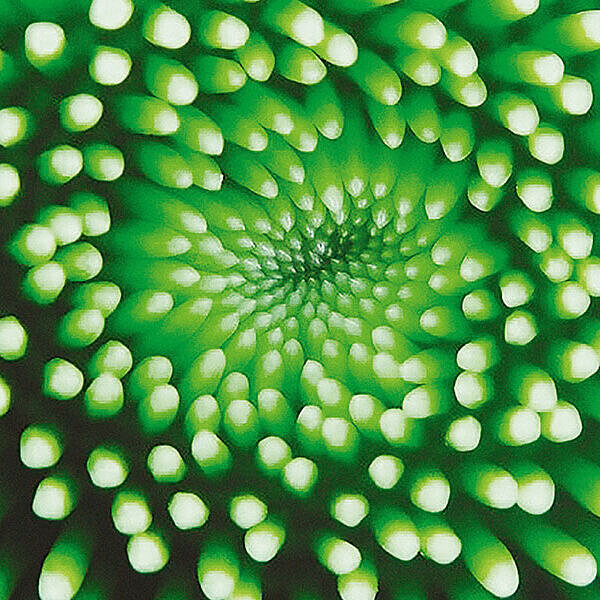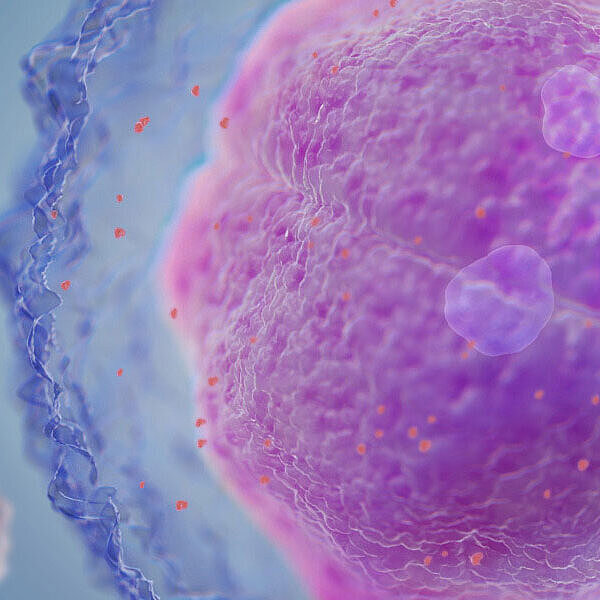The white blood cell differential count application ‘DIFF’
Analysing white blood cell (WBC) differentials on Sysmex’s haematology analysers consists of a cytochemical reaction of the cells with specific, proprietary reagents, followed by fluorescence flow cytometric analysis.
The WBC differential application uses information from two analysis channels (WDF and WNR) and provides absolute and percentage counts of the WBC subpopulations NEUT, LYMPH, MONO, EO, BASO and immature granulocytes (IG), and flag information in cases of abnormalities, so that you can detect abnormal blood count results.
With the optional licence for the Extended Inflammation Parameters, additional advanced clinical parameters become available for enhanced diagnostic support once a malignancy has been excluded.
WBC analysis with fluorescence flow cytometry
The specially developed lysis reagent initially perforates the cell membranes while leaving the cells largely intact. The fluorescence marker then labels the intracellular nucleic acids (mostly RNA). The composition of these two reagents effects a mild reaction with the white blood cells so that almost all of their cellular structure remains intact. This means that optimal separation of the WBC subpopulations is achieved.
The sample is then analysed using fluorescence flow cytometry. The measurement signals related to forward scatter (FSC), side scatter (SSC) and side fluorescence (SFL) are analysed and depicted in different two-axis scattergrams, or alternatively in a 3D scattergram (XR-Series only). Cells with similar cytochemical properties fall within the same area in the scattergram and can be separated using an advanced software algorithm.
The WNR (left) and the WDF (right) scattergrams showing a normal cell distribution.
WDF scattergram
WNR Scattergram
The combined information about membrane composition and cytoplasmic RNA (fluorescence), cell size (forward scatter) and intracellular structure (side scatter) is analysed with proprietary algorithms that deliver sensitive detection of reactive, immature or pathological cells in a blood sample.
Benefits for laboratories and clinicians
-
The 3-dimensional DIFF flagging of the XR-Series and XN-Series detects white blood cell abnormalities with great sensitivity* thanks to the special shape recognition of the sub-population clusters. Studies revealed excellent flagging sensitivity and specificity of XN-Series analysers in various patient populations for blasts, abnormal and atypical lymphocytes*.
-
The parameter IG allows already many of our customers to significantly reduce their number of smears – depending on individual threshold values. You can use this parameter to control the smear rate in your laboratory, too.
-
If the WBC count is very low, and a neutrophil count cannot be obtained, samples will be automatically re-measured in the specific ‘Low WBC’ mode as a reflex test. With an increased counting volume, the reliability of the results increases for all WBC differentiation parameters.
-
Sysmex XR-Series and XN-Series offer a comprehensive range of optional parameters and messages that provides valuable information to support treating clinicians, such as the quantification of activated lymphocytes and neutrophils. The combination of the RE-LYMP and AS-LYMP parameters, which quantify the numbers of all reactive lymphocytes and antibody-synthesizing lymphocytes, respectively, provides additional information about the cellular activation of the innate and adaptive immune response. Furthermore, the granularity and reactivity of neutrophils (NEUT-GI and NEUT-RI, respectively) reflect innate immune response to bacterial infections.
* For references to independent publications, please visit our publications or contact your local Sysmex representative.
For Sysmex white papers, please visit our Scientific documents library.
Document for download
